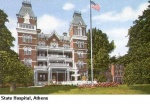Difference between revisions of "Portal:Featured Article Of The Week"
M-Explorer (talk | contribs) |
M-Explorer (talk | contribs) |
||
| Line 1: | Line 1: | ||
{{FAformat | {{FAformat | ||
| − | |Title= | + | |Title= Athens State Hospital |
| − | |Image= | + | |Image= Athens1.jpg |
|Width= 150px | |Width= 150px | ||
| − | |Body= | + | |Body= In 1867 the Ohio Legislature appointed a commission to find a site for an asylum in south-eastern Ohio. A site in Athens was found suitable. Construction began in 1867 and the Athens Lunatic Asylum was completed during 1874. Levi T. Scofield was the architect. The Athens Mental Health Center opened on January 9, 1874 on land purchased from the Coate's farm. The Administration building housed offices of the Superintendent, assistant physicians, steward, and a general reception room for visitors. Two wings added to the building were used for patients. The second floor contained apartments of the medical superintendent. The third and fourth floors were used for administrative offices. |
| − | + | By the 1990s the institution, now known as the Athens Mental Health Center, had vacated the location for a new location. Soon after, the former state asylum campus began a new life as part of nearby Ohio University. Many of the out-buildings have been renovated and put to use, while the Kirkbride now houses the Kennedy Art Museum and some studios for art students. Although the main administration building and some sections of the patient wings have been renovated, much of the Kirkbride is still empty and awaiting reuse. | |
| − | + | Like many other Kirkbrides, the building sits on top of a hill. It faces the nearby Hocking River looking toward the center of Athens and the main campus of Ohio University. The building appears to be in exceptionally good condition, although the cupolas which used to crown parts of the roof are now missing. The ward interiors don't have much in terms of remaining nineteenth-century architectural details either. [[Athens State Hospital|Click here for more...]] | |
}} | }} | ||
Revision as of 05:40, 4 November 2013
Featured Article Of The Week
Athens State Hospital
In 1867 the Ohio Legislature appointed a commission to find a site for an asylum in south-eastern Ohio. A site in Athens was found suitable. Construction began in 1867 and the Athens Lunatic Asylum was completed during 1874. Levi T. Scofield was the architect. The Athens Mental Health Center opened on January 9, 1874 on land purchased from the Coate's farm. The Administration building housed offices of the Superintendent, assistant physicians, steward, and a general reception room for visitors. Two wings added to the building were used for patients. The second floor contained apartments of the medical superintendent. The third and fourth floors were used for administrative offices.
By the 1990s the institution, now known as the Athens Mental Health Center, had vacated the location for a new location. Soon after, the former state asylum campus began a new life as part of nearby Ohio University. Many of the out-buildings have been renovated and put to use, while the Kirkbride now houses the Kennedy Art Museum and some studios for art students. Although the main administration building and some sections of the patient wings have been renovated, much of the Kirkbride is still empty and awaiting reuse.
Like many other Kirkbrides, the building sits on top of a hill. It faces the nearby Hocking River looking toward the center of Athens and the main campus of Ohio University. The building appears to be in exceptionally good condition, although the cupolas which used to crown parts of the roof are now missing. The ward interiors don't have much in terms of remaining nineteenth-century architectural details either. Click here for more...
